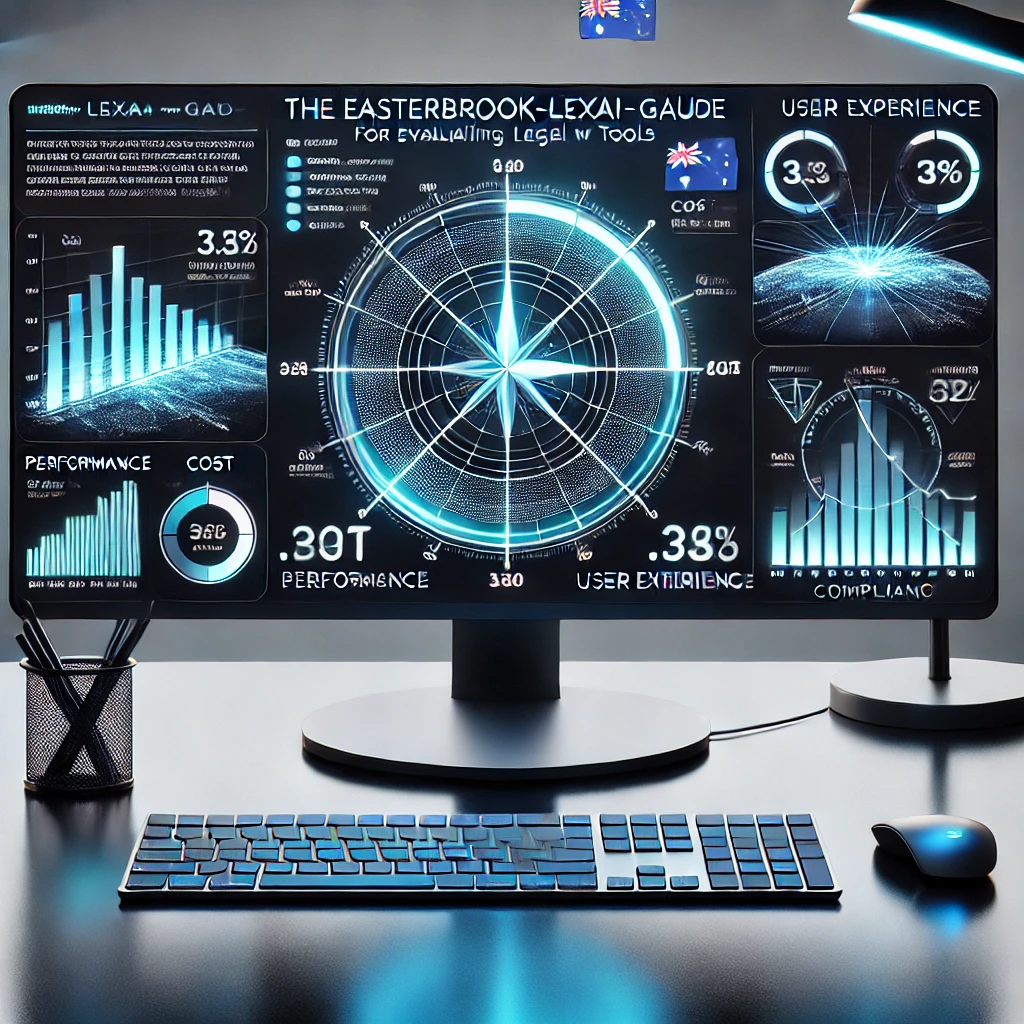The Science Behind Our Legal AI Tools Assessment System
The legal profession is experiencing unprecedented transformation through artificial intelligence technologies. With the proliferation of legal AI tools targeting various aspects of legal practice—from contract analysis to predictive outcomes—legal professionals face increasingly complex technology decisions. How can you determine which legal AI tools will provide genuine value for your specific practice context?
The easterbrook-lexai-gauge methodology was developed to address this challenge by providing objective, data-driven evaluations of legal AI tools based on a rigorous assessment framework. This document details our evaluation methodology, allowing you to understand exactly how our scores are calculated and what they represent.
Foundational Principles of Legal AI Tools Evaluation
Our legal AI tools assessment methodology adheres to several fundamental principles that ensure reliable and meaningful results:
Multi-dimensional Analysis of Legal AI Tools
We recognize that legal AI tools cannot be evaluated along a single dimension. While performance metrics are important, factors such as cost efficiency, compliance safeguards, and user experience significantly impact a tool’s practical value in real-world legal settings. Our methodology examines each legal AI tool across multiple dimensions to provide a holistic assessment.
This approach prevents biased evaluations that might overemphasize technical capabilities while neglecting practicality, or focus too heavily on user interface while overlooking regulatory concerns. By examining legal AI tools through multiple lenses simultaneously, we deliver balanced evaluations that reflect real-world utility.
Context-Sensitive Scoring for Different Legal Environments
The needs of a solo practitioner differ dramatically from those of an enterprise legal department. Our methodology adjusts scoring weights based on firm size and practice priorities, ensuring that evaluations reflect the specific context in which a legal AI tool will be deployed.
For example, enterprise-focused legal AI tools with extensive configuration options might receive lower scores when evaluated for solo practitioners due to implementation complexity, while more streamlined solutions receive appropriate credit for their accessibility. This contextual adjustment ensures that scores meaningfully reflect a tool’s suitability for your specific practice environment.
Evidence-Based Assessment of Legal AI Capabilities
Each score is derived from objective evidence gathered from multiple sources, including vendor specifications, independent testing, user reviews, and regulatory compliance documentation. This approach minimizes subjective bias and provides scores grounded in verifiable data rather than opinion or marketing claims.
We systematically collect and analyze evidence across all evaluation categories, applying consistent standards to ensure comparative validity. This evidence-based approach means you can trust that scores reflect actual capabilities rather than subjective impressions or theoretical potential.
Transparency in Legal AI Tools Evaluation
We believe users should understand how scores are calculated. Our methodology is fully disclosed, with clear documentation of data sources, calculation methods, and the relative weighting of different factors. This transparency allows you to interpret scores with appropriate context and confidence.
Rather than presenting evaluation as a “black box” that produces mysterious scores, we provide comprehensive documentation of our methodology. This transparency builds trust and allows legal professionals to make informed decisions about how to interpret and apply evaluation results.
Dynamic Updating of Legal AI Tools Assessments
Legal AI is evolving rapidly, with new features, performance improvements, and regulatory changes occurring frequently. Our evaluation data is continuously updated to reflect the current state of each legal AI tool, ensuring that scores remain relevant and accurate.
This commitment to currency means that evaluations reflect the present state of legal AI tools rather than outdated information. Regular reassessment captures improvements, deterioration, or changing regulatory contexts that might affect a tool’s value proposition.
Comprehensive Data Collection for Legal AI Tools Evaluation
The foundation of our evaluation system is comprehensive data collection from diverse sources:
Vendor Documentation Analysis
We systematically analyze official materials from legal AI tool providers, including:
- Technical specifications and capability documentation
- Performance benchmarks and testing results
- Implementation requirements and compatibility information
- Pricing structures and licensing models
- Security whitepapers and compliance certifications
This systematic documentation review establishes a baseline understanding of each legal AI tool’s claimed capabilities, limitations, and requirements. While vendor claims are not accepted at face value, they provide essential context for further evaluation.
Independent Testing of Legal AI Tools
For key performance metrics, we conduct or reference independent testing that verifies vendor claims across:
- Accuracy testing across diverse legal document types
- Processing speed and throughput measurements
- Integration testing with common legal practice systems
- Security vulnerability assessments
- Compliance with relevant technical standards
This independent verification ensures that performance metrics reflect actual capabilities rather than marketing aspirations. By testing legal AI tools under controlled conditions, we provide objective measurements of technical performance.
User Feedback on Legal AI Tools Implementation
Real-world user experiences provide crucial insights into how legal AI tools perform in actual practice environments:
- Structured surveys of current users across different firm sizes
- Analysis of public reviews and ratings
- Documented case studies and implementation reports
- User satisfaction metrics for specific features and capabilities
This experiential data captures aspects of legal AI tools that might not be apparent in technical testing, such as usability challenges, implementation hurdles, or unexpected benefits. By incorporating feedback from practicing legal professionals, we ensure our evaluations reflect practical reality.
Regulatory and Compliance Assessment
We assess each legal AI tool’s alignment with relevant regulatory requirements:
- Data protection and privacy capabilities
- Compliance with industry-specific regulations
- Ethical AI implementation standards
- Documentation and audit trail capabilities
- Transparency of AI decision-making processes
This compliance focus ensures that evaluations consider the increasingly important regulatory dimensions of legal AI tools. As legal technology becomes more sophisticated, regulatory compliance becomes an essential component of overall value.
Legal AI Tools Evaluation Categories and Metrics
The easterbrook-lexai-gauge evaluates legal AI tools across four primary categories, each encompassing multiple specific metrics:
Performance Metrics (25% of base score)
Performance metrics assess the legal AI tool’s core technical capabilities and effectiveness:
- Accuracy Rate: Measured as the percentage of correct outputs across various legal document types and tasks. We examine error rates, false positives/negatives, and consistency across different inputs.
- Processing Efficiency: Speed and resource utilization when handling typical workloads. This includes processing times for standard tasks and resource consumption (memory, CPU, bandwidth) required.
- Domain Coverage: Breadth of legal domains effectively addressed. We assess how comprehensively the tool covers relevant legal domains (e.g., contracts, litigation, compliance) for its intended purpose.
- Language Support: Range of languages and jurisdictions handled effectively. This evaluates multilingual capabilities and jurisdiction-specific features for international practices.
- Advanced Feature Set: Availability and effectiveness of specialized capabilities. This examines distinctive features that differentiate the tool from alternatives in its category.
- Scalability: Performance consistency when processing larger volumes. We test how performance metrics change when the tool processes increasing volumes of documents or requests.
Performance scores reflect how effectively a legal AI tool accomplishes its core technical functions, providing insight into its fundamental capabilities.
Cost Efficiency Metrics (25% of base score)
Cost metrics evaluate the legal AI tool’s value proposition relative to its capabilities:
- Acquisition Cost: Initial licensing or subscription fees relative to comparable legal AI tools. This compares pricing against industry averages for similar functionality.
- Implementation Expense: Typical costs for deployment, integration, and training. This includes both direct expenses and indirect costs like staff time.
- Operational Overhead: Ongoing resources required for effective utilization. This examines maintenance requirements, support needs, and administration burden.
- Scaling Economics: How costs change as usage expands. This analyzes pricing models to determine how costs evolve with increased utilization.
- ROI Timeline: Typical timeframe for realizing positive return on investment. This estimates how quickly cost savings or efficiency gains offset investment.
- Value Alignment: Cost proportionality to delivered capabilities. This assesses whether pricing aligns reasonably with the value provided.
Cost efficiency scores provide context for evaluating legal AI tools within budgetary constraints, helping identify solutions that deliver appropriate value for their cost.
User Experience Metrics (25% of base score)
User experience metrics assess how effectively legal professionals can utilize the legal AI tool:
- Interface Intuitiveness: Ease of navigation and operation without extensive training. This evaluates how readily users can accomplish core tasks without reference to documentation.
- Learning Curve: Time and effort typically required to achieve proficiency. This measures the training investment needed to utilize the tool effectively.
- Workflow Integration: Seamless incorporation into existing legal processes. This examines how the tool connects with common legal workflows and other systems.
- Output Clarity: Comprehensibility and actionability of the tool’s results. This assesses how effectively the tool communicates its findings or recommendations.
- Customization Options: Ability to adapt to specific practice requirements. This evaluates configuration capabilities and adaptability to different use cases.
- Accessibility Compliance: Adherence to accessibility standards. This examines compatibility with assistive technologies and compliance with relevant accessibility guidelines.
User experience scores reflect how effectively legal professionals can leverage a tool’s capabilities, recognizing that technical excellence is only valuable if practitioners can effectively utilize it.
Compliance Metrics (25% of base score)
Compliance metrics evaluate regulatory safeguards and governance features:
- Data Security: Protection measures for sensitive legal information. This examines encryption, access controls, and security certifications.
- Privacy Controls: Mechanisms for maintaining client confidentiality. This assesses data handling practices, privacy settings, and compliance with relevant privacy regulations.
- Ethical AI Implementation: Safeguards against bias and discriminatory outcomes. This evaluates bias detection, mitigation measures, and algorithmic transparency.
- Transparency: Visibility into how AI derives its conclusions. This examines explainability features and documentation of decision processes.
- Audit Capabilities: Tracking and documentation of system activities. This assesses logging, record-keeping, and ability to demonstrate compliance.
- Regulatory Alignment: Compatibility with relevant legal and ethical standards. This evaluates adherence to jurisdiction-specific requirements and industry standards.
Compliance scores address increasingly critical concerns about regulatory risk in legal AI tools, helping identify solutions that meet ethical and legal requirements.
The Legal AI Tools Scoring Algorithm Explained
Our scoring system converts raw data into a meaningful 0-100 scale through a multi-step process:
1. Metric Normalization for Consistent Legal AI Tools Comparison
Raw data points for each legal AI tool are normalized to a consistent scale, allowing valid comparisons between different tools and different metrics. For each metric, we establish:
- Minimum threshold values that represent baseline acceptable performance
- Target values that represent excellent performance
- Appropriate scaling between these points (linear, logarithmic, etc.)
For example, contract review accuracy might be scaled where 85% accuracy = 50 points, 95% accuracy = 75 points, and 98% accuracy = 90 points, reflecting the increasing difficulty of achieving higher accuracy levels. This normalization ensures that different metrics can be meaningfully combined despite their different native scales.
2. Category Aggregation Across Legal AI Tool Dimensions
Within each category, normalized metric scores are combined using a weighted average that reflects the relative importance of each metric within that category. These weights are derived from:
- Survey data from legal professionals regarding feature priorities
- Analysis of actual usage patterns across different practice types
- Correlation studies between specific metrics and overall satisfaction
This weighted aggregation ensures that the most influential metrics within each category receive appropriate emphasis in the category score.
3. Priority-Based Weighting for Customized Legal AI Evaluation
The standard category weights (25% each) are adjusted based on user-specified priorities. When a user indicates higher priority for a category, its weight is increased proportionally, while lower-priority categories receive reduced weight.
For example, if a user sets performance priority to 8/10 while keeping other categories at 5/10, the performance category weight might increase from 25% to 35%, with the remaining categories adjusted downward proportionally. This priority adjustment ensures that the overall score reflects your specific evaluation priorities.
4. Firm Size Contextualization for Relevant Legal AI Assessment
Scoring is further contextualized based on firm size selection. This adjusts the evaluation to reflect different requirements across practice scales:
- Solo/Small Firm Context: Greater emphasis on cost efficiency, ease of implementation, and generalist capabilities
- Mid-Size Firm Context: Balanced weighting across all factors, with moderate emphasis on scalability
- Large/Enterprise Context: Increased emphasis on integration capabilities, governance features, and specialized functions
This contextualization ensures that scores reflect suitability for your specific practice environment rather than generic excellence.
5. Composite Score Calculation for Overall Legal AI Tools Rating
The final overall score is calculated as a weighted sum of the four category scores, using the priority-adjusted weights. This composite score represents the legal AI tool’s overall suitability for your specific context and priorities.
The resulting 0-100 scale provides an intuitive measure of fitness-for-purpose, with higher scores indicating better alignment with your specific requirements.
Validation of Legal AI Tools Evaluation Methodology
Our methodology undergoes continuous validation to ensure the accuracy and relevance of our evaluations:
Benchmarking and Calibration
We regularly benchmark our evaluation results against:
- Documented outcomes from actual legal AI tool implementations
- Comparative analyses from legal technology experts
- Aggregated user satisfaction data
This benchmarking allows us to calibrate our scoring algorithm to ensure that numerical scores align with real-world experience. When discrepancies emerge between calculated scores and observed outcomes, we refine our methodological approach.
Expert Review Panel for Legal AI Assessment
Our methodology and evaluation results are periodically reviewed by a panel of experts including:
- Legal technology specialists with deep domain knowledge
- Legal practitioners from various firm sizes and practice areas
- Data scientists with expertise in evaluation systems
- Legal ethics and compliance professionals
This multi-disciplinary review helps identify potential gaps or biases in our approach, ensuring that our evaluation methodology remains robust and relevant.
Continuous Methodology Refinement
We systematically refine our methodology based on:
- Feedback from users of the easterbrook-lexai-gauge tool
- Emerging standards and best practices in legal AI
- New research on evaluation methodologies
- Changes in the legal technology landscape
This continuous improvement approach ensures that our evaluation methodology evolves alongside the rapidly developing legal AI market.
Limitations and Considerations in Legal AI Tools Evaluation
We believe in transparent acknowledgment of the inherent limitations in any evaluation system:
Temporal Validity of Legal AI Tool Scores
Tool evaluations represent a snapshot in time. While we continuously update our data, rapid development cycles in legal AI mean that tools can change significantly between evaluations. Users should consider recency when interpreting scores.
Contextual Boundaries of Legal AI Assessment
While our system adjusts for firm size and user priorities, it cannot account for every unique practice situation. Users should consider scores as informative guidance rather than absolute judgments, and interpret them within their specific practice context.
Data Availability Constraints
Our evaluations can only incorporate data that is available for assessment. Newer legal AI tools or those with limited market presence may have less comprehensive evaluation data, potentially affecting score reliability.
Subjective Elements in Legal Technology Evaluation
Despite our emphasis on objective metrics, some aspects of evaluation inevitably involve subjective judgment, particularly regarding user experience factors. We mitigate this through multiple evaluators and explicit criteria, but some subjectivity remains inherent.
Applying Legal AI Tools Evaluation Results Effectively
To gain maximum value from the easterbrook-lexai-gauge evaluations, we recommend:
Compare Multiple Legal AI Tools
Evaluate several tools targeted at your specific needs to understand the range of available options. Relative scores often provide more insight than absolute values, helping identify comparative advantages among alternatives.
Review Category Scores for Legal AI Solutions
Look beyond the overall score to understand specific strengths and weaknesses across the four evaluation categories. A tool might have an acceptable overall score while excelling or struggling in areas particularly important to your practice.
Adjust Priorities to Test Legal AI Tools Evaluation Sensitivity
Experiment with different priority settings to see how sensitive the evaluation is to changes in your weighting preferences. This sensitivity analysis can reveal how robust your preference for a particular tool might be.
Consider Score Trends for Legal AI Products
For established tools, observe how scores have changed over time to identify improvement or deterioration trends. These trends may indicate a vendor’s commitment to ongoing development or emerging issues.
Combine with Direct Testing of Legal AI Tools
Use evaluation scores to create a shortlist, then conduct your own hands-on testing of the most promising tools. Direct experience remains valuable for confirming evaluation results in your specific practice context.
Conclusion: A Rigorous Framework for Legal AI Tools Evaluation
The easterbrook-lexai-gauge methodology represents our commitment to providing legal professionals with reliable, context-sensitive evaluations of legal AI tools. By combining rigorous data collection, sophisticated scoring algorithms, and transparent documentation, we aim to simplify the complex process of legal technology selection.
We welcome feedback on our methodology and continuously strive to enhance the accuracy, relevance, and utility of our evaluation system. As the legal AI landscape evolves, so too will our approach to assessment, ensuring that the easterbrook-lexai-gauge remains a valuable resource for legal professionals navigating technological change.
For more information on how to use the easterbrook-lexai-gauge calculator effectively, please see our User Guide. To explore real-world applications of our evaluation methodology, visit our Case Studies section.








